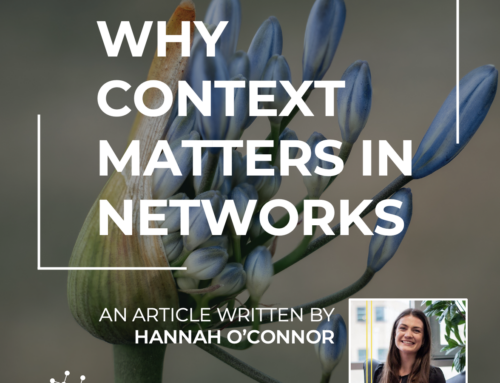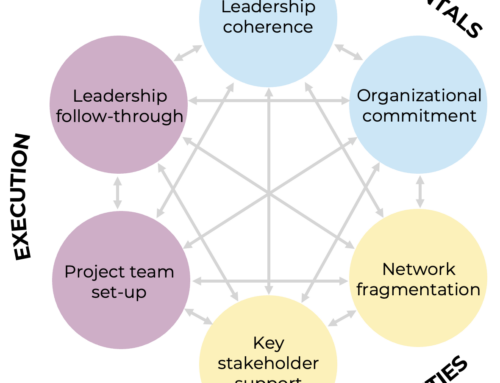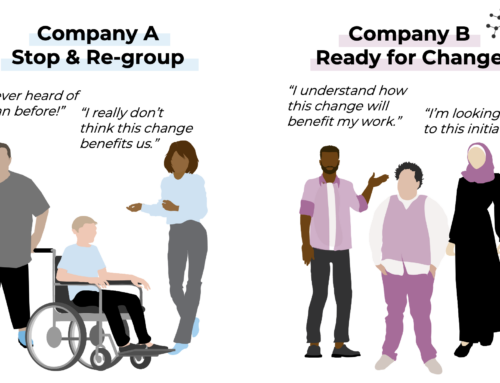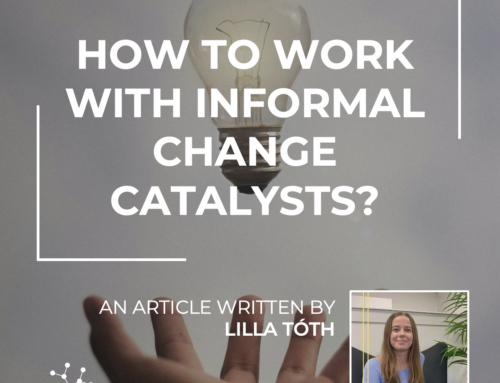INFORMAL NETWORKS
The Power Of Social Networks In The Current Business Reality
September 1st, 2021 | Informal networks

Our Head of Learning, Innovation & Quality, Richard Santos Lalleman, was invited for an interview about the power of social networks in the current business reality.
We know that social networks are an integral part of our lives, but what are the challenges of building effective networks within and across organizations? What are the blind spots that we might miss out?
[Richard Santos Lalleman]
The simple answer is that our blind spots within and across organizations are our unconscious biases.
Let me explain this a bit more in detail.
Even though the human brain is capable of incredible things, it is also extremely flawed at times. And this is because we tend to make all sorts of mental mistakes … In science these mistakes are better known as “cognitive biases”. These biases really affect both how we think and also what we do … or in other words … how we make sense and act on different situations in our organizations. And the difficulty with these biases is that they often happen unconsciously.
So, how can we avoid this [unconcious biases] and turn it into opportunities to build effective organizational networks?
That is what I am working on 100% of my time inside Innovisor. To unlock the potential of people by bringing the evidence to the table on the unconscious biases inside organizations. Because that way companies know what to focus on to succeed with their organizational initiatives.
This evidence is a result of analyzing or diagnosing the informal organizational networks – which is better known as social or organizational network analysis.
Can you share with us a couple of example what happens when you ignore the evidence?
[Richard Santos Lalleman]
Ten years ago, I worked for a global professional service company with at that time around 170,000 employees. The company was really on the forefront to build a networked and inclusive working environment. This was their go-to-market strategy, because they knew that their clients were also acting globally. So, their employees needed to create global solutions. That’s why the employees needed to change the way they worked.
And really the reason why I mention that they were on the forefront is because this is currently still a pressing topic for many companies: work and think globally, act locally … 10 year later …
This is not only a pressing topic for global companies. Local companies are also struggling mainly because of the COVID-19 pandemic … because no matter the size of your company or the market focus, employees are either working from home or work in a hybrid mode. They just struggle to create meaningful and purposeful connectivity.
But let me go back to this professional service company. To help all employees to change the way they needed to work, they had created a network of people who needed to champion the new behavior. The idea was that these champions would then get the rest of organization onboard. I am pretty sure you have heard of these kind people. They are the company’s change ambassadors, change agents, or change catalysts.
Even though they had the best intentions – both the global transformation team and the change ambassadors – this change program failed.
Why did the change program fail?
[Richard Santos Lalleman]
It really was because these change ambassadors were identified based on subjective assessments – not objective assessments. The leaders had nominated some of their people as the change ambassadors. They were either the ones who were the yes-men to leaders, or the ones who were sitting on the bench not billing hours to the client. So, what was really forgotten in this change program was that these people were only trusted or nominated by the top, not from the bottom by the employees. And that’s a problem, because 88% of companies are just employees.
88% of companies are just employees
So, in this case, they just lacked the capability to influence the whole organization. They didn’t have the evidence on who were the real influencers.
So, just to get back to your original question about blind spots. I really believe that the most important blind spot in building effective networks is that you need to make decisions based on evidence.
So, missing evidence is important. Can you give us another example to show what the blind spots are faced by companies?
[Richard Santos Lalleman]
In Innovisor, we have seen a clear pattern on what makes people NOT to connect with each other. Or in other words:
what are the common unconscious barriers between people
Some of these barriers are obvious, such as location. Because obviously, the connectivity between an office in Moscow and an office in Mexico City is just limited, just because there is a time difference.
But a location barrier can also be between offices that are located in the same street … or teams located on different floors inside one building … or just the connectivity between the Headquarter and non-Headquarter offices.

This is exactly what you see in this network visualization. You can see a life science company with around 600 employees. When we started working with this company, they told us that they had the best culture in the industry in the country. Our work was the re-assess and confirm. However, the first thing we saw was that the organization wasn’t connected well. Yes …. They were connected as you can see at the right top, but there was clearly a part of the organization acting as a silo.
When we showed this to leadership, they were not expecting this. And it turned out that the silo was their affiliate in another country. This location barrier had a hidden story: 15 months prior to our assessment, this country was acquired. Clearly, they had forgotten about a critical part for acquisitions … integration! The same critical part we forget when running diversity and inclusion programs.
This was huge risk because not only the organizational structure was fragile, but it also had a disengaged workforce in the affiliate. They didn’t feel informed, and they perceived the culture negatively. So, they didn’t have the best culture.
So, in this example location was a barrier, but not because of time zone but more because they just thought the positive culture embraced the new acquisition. That’s wrong! You really need to be disciplined to build inclusive organizations. Collaborative relationships are sticky and we sometimes have not more bandwidth to collaborate with more and new people.
Besides location there are also three other common and unconscious barriers or blind spots. These are job functions, the hierarchy in the company and how long people have been with the company.
For example, 65% of all interactions of HR employees are with HR employees. Is this what you want your business support functions be – more inward then outward working?
How do social networks shape organizations, businesses and communities in the current business reality? How has the Pandemic changed the notion of networks & building connections?
[Richard Santos Lalleman]
One of the key consequences that the COVID-19 pandemic has had on the social networks inside organizations is on collaboration. In this case, integration or onboarding is one of these blind spots or unconscious barriers.
To illustrate this, I brought this graph with me to explain you this.

You see two graphs with the horizontal axis presenting how long you have been with a company and the vertical axis the level of integration. Each graph consists of a yellow dotted line showing the average number of collaboration relationships in companies. The blue moving line shows the average collaboration relationships. So, when you just have joined a company, you of course have limited collaborative relationships, whereas if you have been with the company, you have more collaborative relationships.
The graphs show two invisible consequences of COVID-19.
The first consequence is that newcomers’ integration time has doubled.
This is an issue because the faster you integrate or onboard your new employees, the quicker this impact time-to-adding value. Before COVID.19, it took companies 2 years to get new employees integrated. During COVID-19, this takes longer. The time that a new employee is integrated into the collaborative networks as anyone else in the company has doubled. This does not only result in the risk of keeping reinventing the wheel because people are not completely aware of what is going on in the company due to their lack of integration; it is also just a waste of resources.
And this becomes really a waste when you are not becoming disciplined with your onboarding practices. New employees will be continuing to come on board as economies recover. Getting them productive will require more than preparing them to perform the practical aspects of the new roles. They will need to know how to be connected with the right people, why the organization behaves the way it does and above all, what to prioritize.
The second consequence is that collaboration got weaker.
It has dropped by 30%. And again, this matter a lot, because collaboration is the engine for companies to survive in the ever-changing environment. That’s why companies should keep a focus on collaboration while its people work from home or moving into hybrid working environments.
This new way of working for many of us cannot only be left to the individual. It requires an organizational initiative. Of course, there will always be individuals who feel collaboration got better, but make sure the rest of the organization is not left out.

INFORMAL NETWORKS
The Power Of Social Networks In The Current Business Reality
September 1st, 2021 | Informal networks

Our Head of Learning, Innovation & Quality, Richard Santos Lalleman, was invited for an interview about the power of social networks in the current business reality.
We know that social networks are an integral part of our lives, but what are the challenges of building effective networks within and across organizations? What are the blind spots that we might miss out?
[Richard Santos Lalleman]
The simple answer is that our blind spots within and across organizations are our unconscious biases.
Let me explain this a bit more in detail.
Even though the human brain is capable of incredible things, it is also extremely flawed at times. And this is because we tend to make all sorts of mental mistakes … In science these mistakes are better known as “cognitive biases”. These biases really affect both how we think and also what we do … or in other words … how we make sense and act on different situations in our organizations. And the difficulty with these biases is that they often happen unconsciously.
So, how can we avoid this [unconcious biases] and turn it into opportunities to build effective organizational networks?
That is what I am working on 100% of my time inside Innovisor. To unlock the potential of people by bringing the evidence to the table on the unconscious biases inside organizations. Because that way companies know what to focus on to succeed with their organizational initiatives.
This evidence is a result of analyzing or diagnosing the informal organizational networks – which is better known as social or organizational network analysis.
Can you share with us a couple of example what happens when you ignore the evidence?
[Richard Santos Lalleman]
Ten years ago, I worked for a global professional service company with at that time around 170,000 employees. The company was really on the forefront to build a networked and inclusive working environment. This was their go-to-market strategy, because they knew that their clients were also acting globally. So, their employees needed to create global solutions. That’s why the employees needed to change the way they worked.
And really the reason why I mention that they were on the forefront is because this is currently still a pressing topic for many companies: work and think globally, act locally … 10 year later …
This is not only a pressing topic for global companies. Local companies are also struggling mainly because of the COVID-19 pandemic … because no matter the size of your company or the market focus, employees are either working from home or work in a hybrid mode. They just struggle to create meaningful and purposeful connectivity.
But let me go back to this professional service company. To help all employees to change the way they needed to work, they had created a network of people who needed to champion the new behavior. The idea was that these champions would then get the rest of organization onboard. I am pretty sure you have heard of these kind people. They are the company’s change ambassadors, change agents, or change catalysts.
Even though they had the best intentions – both the global transformation team and the change ambassadors – this change program failed.
Why did the change program fail?
[Richard Santos Lalleman]
It really was because these change ambassadors were identified based on subjective assessments – not objective assessments. The leaders had nominated some of their people as the change ambassadors. They were either the ones who were the yes-men to leaders, or the ones who were sitting on the bench not billing hours to the client. So, what was really forgotten in this change program was that these people were only trusted or nominated by the top, not from the bottom by the employees. And that’s a problem, because 88% of companies are just employees.
88% of companies are just employees
So, in this case, they just lacked the capability to influence the whole organization. They didn’t have the evidence on who were the real influencers.
So, just to get back to your original question about blind spots. I really believe that the most important blind spot in building effective networks is that you need to make decisions based on evidence.
So, missing evidence is important. Can you give us another example to show what the blind spots are faced by companies?
[Richard Santos Lalleman]
In Innovisor, we have seen a clear pattern on what makes people NOT to connect with each other. Or in other words:
what are the common unconscious barriers between people
Some of these barriers are obvious, such as location. Because obviously, the connectivity between an office in Moscow and an office in Mexico City is just limited, just because there is a time difference.
But a location barrier can also be between offices that are located in the same street … or teams located on different floors inside one building … or just the connectivity between the Headquarter and non-Headquarter offices.

This is exactly what you see in this network visualization. You can see a life science company with around 600 employees. When we started working with this company, they told us that they had the best culture in the industry in the country. Our work was the re-assess and confirm. However, the first thing we saw was that the organization wasn’t connected well. Yes …. They were connected as you can see at the right top, but there was clearly a part of the organization acting as a silo.
When we showed this to leadership, they were not expecting this. And it turned out that the silo was their affiliate in another country. This location barrier had a hidden story: 15 months prior to our assessment, this country was acquired. Clearly, they had forgotten about a critical part for acquisitions … integration! The same critical part we forget when running diversity and inclusion programs.
This was huge risk because not only the organizational structure was fragile, but it also had a disengaged workforce in the affiliate. They didn’t feel informed, and they perceived the culture negatively. So, they didn’t have the best culture.
So, in this example location was a barrier, but not because of time zone but more because they just thought the positive culture embraced the new acquisition. That’s wrong! You really need to be disciplined to build inclusive organizations. Collaborative relationships are sticky and we sometimes have not more bandwidth to collaborate with more and new people.
Besides location there are also three other common and unconscious barriers or blind spots. These are job functions, the hierarchy in the company and how long people have been with the company.
For example, 65% of all interactions of HR employees are with HR employees. Is this what you want your business support functions be – more inward then outward working?
How do social networks shape organizations, businesses and communities in the current business reality? How has the Pandemic changed the notion of networks & building connections?
[Richard Santos Lalleman]
One of the key consequences that the COVID-19 pandemic has had on the social networks inside organizations is on collaboration. In this case, integration or onboarding is one of these blind spots or unconscious barriers.
To illustrate this, I brought this graph with me to explain you this.

You see two graphs with the horizontal axis presenting how long you have been with a company and the vertical axis the level of integration. Each graph consists of a yellow dotted line showing the average number of collaboration relationships in companies. The blue moving line shows the average collaboration relationships. So, when you just have joined a company, you of course have limited collaborative relationships, whereas if you have been with the company, you have more collaborative relationships.
The graphs show two invisible consequences of COVID-19.
The first consequence is that newcomers’ integration time has doubled.
This is an issue because the faster you integrate or onboard your new employees, the quicker this impact time-to-adding value. Before COVID.19, it took companies 2 years to get new employees integrated. During COVID-19, this takes longer. The time that a new employee is integrated into the collaborative networks as anyone else in the company has doubled. This does not only result in the risk of keeping reinventing the wheel because people are not completely aware of what is going on in the company due to their lack of integration; it is also just a waste of resources.
And this becomes really a waste when you are not becoming disciplined with your onboarding practices. New employees will be continuing to come on board as economies recover. Getting them productive will require more than preparing them to perform the practical aspects of the new roles. They will need to know how to be connected with the right people, why the organization behaves the way it does and above all, what to prioritize.
The second consequence is that collaboration got weaker.
It has dropped by 30%. And again, this matter a lot, because collaboration is the engine for companies to survive in the ever-changing environment. That’s why companies should keep a focus on collaboration while its people work from home or moving into hybrid working environments.
This new way of working for many of us cannot only be left to the individual. It requires an organizational initiative. Of course, there will always be individuals who feel collaboration got better, but make sure the rest of the organization is not left out.

Related articles
Share article
Share article









